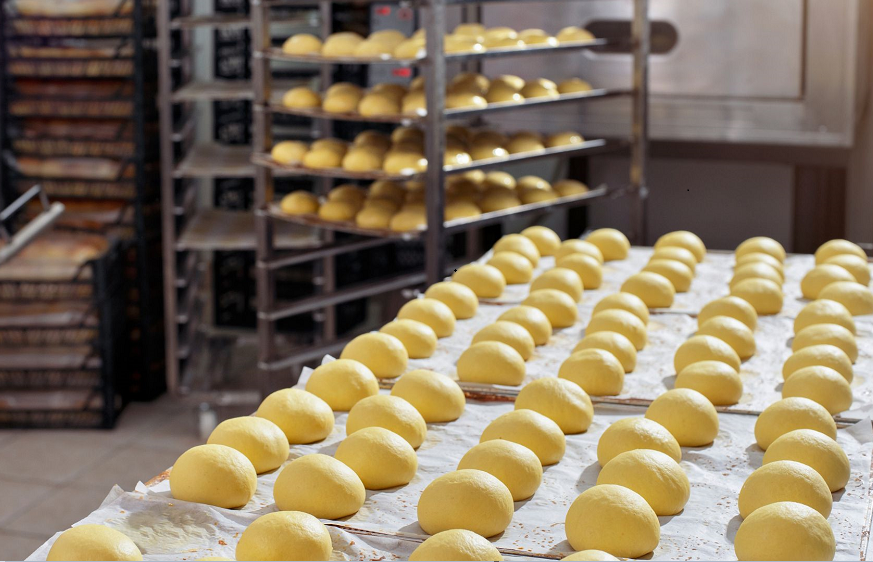How are enzymes used in the bakery industry
What is the enzyme functionality in bakery applications?
Bakery products have experienced significant developments globally and nationally, driven by increased consumption according to sales data for bakery products in the market. The estimated size of the worldwide bakery market was 2.89 billion USD in 2019, and it is anticipated to grow at a CAGR of 3.8% from 2020 to 2030 to reach USD 4.36 billion. Bakery products include cakes, pastries, biscuits, bread, cereals, and bakery products. Consumer demand has a major influence on people’s lifestyles. Lifestyle preference can be used as a reference to provide bakery consumer demand. A dynamic lifestyle requires the availability of new bakery produce (fresh), so it is necessary to pay attention to an effective and efficient way to maintain product shelf life.
How to maintain shelf life and improve the quality of bakery products?
One alternative to maintain shelf life and improve the quality of bakery products is by using enzymes as food additives and processing aids. According to Title 21 of the Code of Federal Regulations (CFR), “food additives” are all compounds that are not specifically prohibited by Article 201 of the law and whose usage either directly or indirectly affects food characteristics or results in those qualities being changed.
What are the processing aids?
Processing aids are substances that help with technical aspects of food production in the manufacturing process. Codex Alimentarius Commission provides a four-point approach to determining a substance that qualifies as a processing aid, with the main criterion that the substance “meets certain technological objectives during treatment or processing. Processing aid is generally not required to be listed on food packaging labels, even if their use contains allergen priority or origin from animals that require proper labeling. Such labeling to avoid unintentional consumption by individuals with dietary restrictions of the substance.
What are enzymes in the bakery industry, and how do they work?
Enzymes are proteins with catalytic properties. They are biocatalysts that can accelerate chemical reactions under fairly benign conditions (temperature, pH, etc.) by lowering the reaction’s activation energy while remaining unaltered in the process. Enzymes are very specialized in how they are used. If they are sufficiently pure, they act only when small amounts are added and only on certain targets. They are fully natural in their original sources. They can only be obtained through extraction from plant and animal tissues and fluids or by fermentation with microbes. Individual enzymes have distinct characteristics and traits depending on where they came from (different enzyme sources or organisms). Enzymes have a very specialized substrate binding site (active center), which allows them to behave in a substrate- or effect-specific manner that is occasionally stereoselective. Enzymes are intriguing catalysts for the commercial and artisanal manufacturing of foods, as well as for analytical applications, due to their specificity and high level of efficacy. They can be used as single enzymes or combination enzymes.
How to use enzymes as a substitute for emulsifiers?
How to use enzymes related to the determination of regulation, type, and mechanism of action enzyme?. Thus, knowledge related to the integration of enzymes with processing for bakery products including bread, biscuits, pastries, cookies, crackers, pies, and others else is needed. The integration of enzymes and processing is related to the innovation of researchers and developers to use enzymes as an alternative to chemical-based emulsifiers. These substitutions will provide added value to bakery products as clean-label food ingredients.
Background on the use of enzymes as substitutes emulsifiers can be explained through several approaches as follows: a) Use of emulsifiers in bakery products have the potential give a negative impact on health b) Trends in the consumption of clean labels in bakery products c) alternative emulsifier substitution with enzymes to meet the trend clean label food.
Can emulsifiers in bakery products have a negative impact on health?
Improving the quality of bakery products can be done by adding emulsifiers. The emulsifier that is usually added to bread is Mono- and diglycerides of fatty acids (glyceryl monostearate, glyceryl di stearate), diacetyl tartaric acid ester of mono- and diglycerides (DATEM), and Sodium stearoyl-2-lactylate. The emulsifier is included in a synthetic/chemical emulsifier that increases volume and improves bread texture. Even though it has benefits for the quality of the final bread product, there are potential health risks if consumed not by ADI (Acceptable Daily Intake) rules. Based on several research results, chemical emulsifiers are included in food additives that cause acute inflammation, such as intestinal inflammation, obesity associated with metabolic syndrome, and glucose resistance.
European Food Safety Authority (EFSA) re-evaluated the emulsifier as a food additive. In 2014, EFSA’s Emerging Risks Exchange Network considered the effect of emulsifier food on the intestinal dividing wall to be re-examined through scientific studies. The preferred type of emulsifier to be reviewed includes emulsifiers that are added to food (bread included) and often consumed. These emulsifiers include sodium stearoyl-2-lactylate, DATEM, mono- and diglycerides of fatty acids, emulsifiers applied in infant formula (CITREM, sucrose esters of fatty acids, mono- and diglycerides of fatty acids), and emulsifiers that have hydrophilic–lipophilic values high balance (HLB). Most toxicology studies use emulsifier animals and are limited to humans. Therefore, it is crucial to identify which emulsifier is most likely to result in negative health effects with long-term exposure in people who exceed the ADI. This requires further investigation through controlled experiments carried out with sufficient personnel.
What is a clean label?
The current definition of clean labels can be used to improve the understanding of consumers, producers, and policy makers. Clean label is a food derived from natural ingredients, organic, and free from additives or preservatives considered superior for consumers. The clean label indicates the product with minimal processing and does not contain ingredients that provide a negative perception of consumers. Ingredients that cause negative perceptions for consumers include ingredients that contain allergens, additives, and chemicals. Some consumers understand clean labels as products that contain little to no processed ingredients, artificial flavours, dyes, synthetic additives, and unwanted allergens.
What is the trend of clean label consumption on bakery products?
Consumer doubts about food additives (E-number) raise a shift in preference towards ‘clean label’ food. Clean label preference follows a style of consumer life that leads to healthy food. Currently, there is no fixed definition of clean label regulations recommended by the Food and Drug Administration (FDA). Therefore, food companies must use consumer demand references and trends market to determine whether the product meets the expectations of the clean label definition.
What are the benefits of using enzymes in food processing?
Enzymatic modification is more beneficial than chemical modification for several reasons, namely technology enzymes as clean processes with energy consumption and low waste production as well as favourable working conditions safe none/slightly toxic. In contrast to chemical modification, enzymes do not affect the nutritional value of wheat gluten, enzymes are a biodegradable protein of the type denatured during baking and preferably as clean label food additives are, a good alternative to chemical additives. Enzyme modification increases the water absorption capacity, viscoelasticity, and rheological properties (bread taste, volume, crumb structure, and shelf life) on weak gluten bonds, improving dough and bread quality. Also, enzymes can hydrolyse or crosslink gluten protein according to the type of enzyme and improve the emulsification, solubility, and foaming properties of this protein.
Microbial enzymes play an important role in food companies because they are more stable than enzymes from plants and animals. Enzymes are cost-effectively produced by fermentation techniques with a short time and little space requirements, have high consistency, easy process modification and optimization. The selection of enzymes for chemical substitution in dough and bread improvers is an alternative that provides benefits not only for consumers but also producers and the environment. Therefore, there is a need for further studies on the extent to which enzymes, especially single enzymes, have the potential to be applied to bakery products to produce clean product labels. In general, the discussion of the potential of the enzyme can be done using several approaches such as i) Enzyme application in bakery products ii) The role of enzymes to improve product quality from processing (mixing dough, fermentation, baking) to the final bakery result including texture and appearance iii) Enzyme mechanisms in improving the quality of bakery products.
References
Bakery market by product (bread, rolls, cakes, pastries, biscuits, pies, and others) by type (snacks, breakfast, hybrids, and specialty), by distribution channel (hypermarkets, supermarkets, specialty stores, and online) global opportunity analysis and industry forecast, 2020–2030. https://www.nextmsc.com. https://www.nextmsc.com/report/bakery-market. Diakses pada 13 Juli 2022.
Kocabas, D.S. dan Grumet, R. 2019. Evolving regulatory policies regarding food enzymes produced by recombinant microorganisms. GM Crops & Food, 10:191–207.
Redan, B.W. 2020. Processing aids in food and beverage manufacturing: Potential source of elemental and trace metal contaminants. Journal of Agricultural and Food Chemistry, A-G.
Aponso, M.M.W, De Silva, G.O dan Abeysundara, A.T. 2017. Emulsifiers as food additives: An overview on the impact to obesity and gut diseases. Journal of Pharmacognosy and Phytochemistry, 6(3): 485-487.
Chassaing, B, Van de Wiele, T., De Bodt, J., Marzorati, M. dan Gewirtz, A.T. 2017. Dietary emulsifiers directly alter human microbiota composition and gene expression ex vivo potentiating intestinal inflammation. Gut Published Online First, 1-14.
Csaki, K.F. dan Sebestyen, E. 2019. Who will carry out the tests that would be necessary for proper safety evaluation of food emulsifiers? Food Science and Human Wellness, 8: 126–135
Halmos, E.P., Mack, A., dan Gibson, P.R. 2019. Review article: Emulsifiers in the food supply and implications for gastrointestinal disease. Aliment Pharmacol Ther, 49: 41–50.
Laster, J., Bonnes, S.L., dan Rocha, J. 2019. Increased use of emulsifiers in processed foods and the links to obesity. Current Gastroenterology Reports, 21: 61.
Partridge, D., Lloyd, K.A., Rhodes, J. M., Walker, A. W., Johnstone, A. M. dan Campbell, B. J. 2019. Food additives: Assessing the impact of exposure to permitted emulsifiers on bowel and metabolic health – introducing the FADiets study. Nutrition Bulletin, 44: 329-349.
Cox, S., Sandall, A., Smith, L., Rossi, M. dan Whelan, K. 2020. Food additive emulsifiers: A review of their role in foods, legislation and classifications, presence in food supply, dietary exposure, and safety assessment. Nutrition Reviews, 79(6): 726–741
Garvey, E.C., O’Sullivan, M.G., Kerry, J.P., Milnerd, L., Gallagher, E., dan Kilcawleya, K.N. 2020. Characterising the sensory quality and volatile aroma profile of clean-label sucrose reduced sponge cakes. Food Chemistry.
Aschemann-Witzel, J., Varela, P., dan Peschel, A.O. 2019. Consumers categorization of food ingredients: Do consumers perceive them as ‘clean label’ producers expect? An exploration with projective mapping. Food Quality and Preference, 71: 117-128.
Nascimento, K., Paes, S.D., dan Augusta, I.M. 2018. A Review ‘Clean Labeling’: Applications of Natural Ingredients in Bakery Products. Journal of Food and Nutrition Research, 6 (5): 285-294.
Singhania, R.R., Sukumarana, R.K., Patel, A.K., Larroche, C., dan Pandey, A. 2010. Advancement and comparative profiles in the production technologies using solid-state and submerged fermentation for microbial cellulases. Enzyme and Microbial Technology, 46: 541–549.
Wouters, G.B., Rombouts, I., Fierens, E., Brijs, K. dan Delcour, J.A. 2016. Relevance of the functional properties of enzymatic plant protein hydrolysates in food systems. Comprehensive Reviews in Food Science and Food Safety, 15: 786-800.
Raveendran, S., Parameswaran, B., Ummalyma, S.B., Abraham, A.A., Mathew, A.K., Madhavan, A., Rebello, S., dan Pandey, A. 2018. Food Technol. Biotechnol, 56 (1): 16-30.










































































